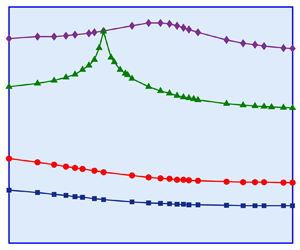Article contents
Effects of elasticity number and time constant ratio on breakup and droplet formation of viscoelastic planar liquid sheet co-flowing with gases of equal velocities
Published online by Cambridge University Press: 04 June 2021
Abstract

A weakly nonlinear investigation of sinuous instabilities in a planar viscoelastic liquid sheet having corotational Jeffrey's rheological model is performed. Analysis predicts that viscoelastic properties may exhibit a non-monotonic dual effect depending upon their range and velocity ratios. At velocity ratios of 2 and 2.15, an increase in elasticity stabilizes the sheet for elasticity number ranging from 0.1 to 4 and from 0.1 to 1, respectively. Beyond this range, elasticity produces a destabilizing effect on the sheet. However, at higher velocity ratios of 2.50 and 2.75, an increase in elasticity only destabilizes the liquid sheet. The effect of time constant ratio at different velocity ratios is opposite to that of elasticity number. An increase in time constant ratio destabilizes the sheet at velocity ratio of 2, whereas it stabilizes the sheet for relatively higher velocity ratios of 2.50 and 2.75. At intermediate velocity ratio of 2.15, two regimes of time constant ratio are identified in the range 0.1 to 0.4 and 0.4 to 0.9, representing stabilizing and destabilizing effect of time constant ratio, respectively. The nonlinear interaction between the viscoelastic sheet and surrounding gases may enhance or dampen the second-order amplitude. The contribution of second-order amplitude to sheet breakup is much higher than that of linear growth rate and is responsible for the dual effect of viscoelastic properties. Finally, the size distribution of droplets formed after primary breakup is investigated using maximum entropy formulation. Results reveal that an increase in elasticity number and time constant ratio produces finer and larger droplets, respectively.
Information
- Type
- JFM Papers
- Information
- Copyright
- © The Author(s), 2021. Published by Cambridge University Press
References
- 6
- Cited by


